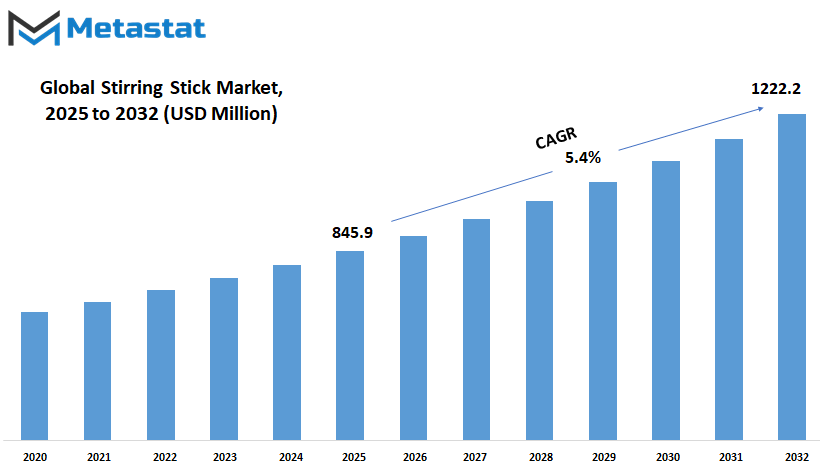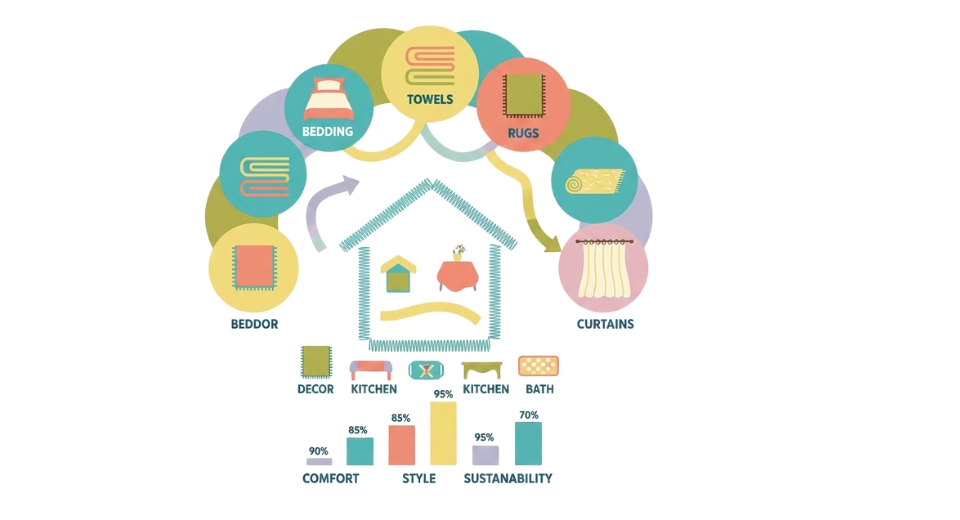MARKET OVERVIEW
The global stirring stick market is a vital element of a number of industries such as food and beverage, pharmaceuticals, and labs. Stirring sticks, which are frequently employed for stirring fluids or blends, are fundamental tools intended to offer effective and consistent outputs. The straightforward yet significant tools guarantee consistency in mixing liquids, powders, or other blends to the satisfaction of professionals and consumers. For the global stirring stick market, these items will be integral to those markets which need careful stirring. For the food and drink sector, there will be steady use of stirring sticks in cafes, restaurants, and pubs, where stirring sticks are an indispensable part of cocktail mixing or mixing ingredients.
The higher consumption of drinks, particularly coffee and cocktails, will make stir sticks remain popular. Wooden, plastic, or metallic will probably be utilized depending on their purpose, providing corporations and consumers with options. Biodegradable and plastic will probably gain even more popularity as the emphasis is placed on being more eco-friendly and going green. The global stirring stick market will also experience continued use in the pharmaceutical sector, where the equipment aids in efficiently mixing solutions and compounds in laboratories. Pharmaceutical developers will need stirring sticks to mix chemical solutions, reagents, and other pharmaceutical preparations. As regulatory standards on laboratory procedures become more stringent, the market for efficient and long-lasting stirring devices will thrive.
Moreover, material innovation, including disposable or sterilized ones, will be essential in keeping pharmaceutical operations intact. Other than the food, beverage, and pharmaceutical sectors, the global stirring stick market will most probably grow in other industries, including cosmetics and chemicals. In the cosmetic line, for instance, stirring sticks are often used in product preparation procedures such as creams, lotions, and other products. Such products need high precision in their preparation, with stirring sticks playing a vital role in achieving uniform consistency in the final product. Likewise, in the chemical industry, stirring sticks will enable mixing and formulation of different substances so that manufacturers and researchers can obtain precise and consistent results in their operations.
There will also be market demand for stirring sticks because of advancements in design and functionality. For instance, innovations leading to ergonomically shaped stirring sticks will be suitable for professionals who want tools to hold for hours. Other than that, there may be rising levels of personalization of stirring sticks, for instance, for use or brand labeling in the food sector. With growing convenience and precision needs across industries, the global stirring stick market will develop, responding to the complex needs of industries. The sustainability trend will also contribute significantly to the market's future, with business organizations opting for greener materials for use in production. Overall, the global stirring stick market will continue to be an institution in most industries due to sheer consistent technological innovation, materials science advances, and unyielding demand for effective and secure mixing technology.
Global stirring stick market is estimated to reach $1222.2 Million by 2032; growing at a CAGR of 5.4% from 2025 to 2032.

GROWTH FACTORS
The global stirring stick market has received immense attention in the recent past, and there are some factors that will determine its future. Stirring sticks have remained in continuous demand across all industries because they have been found to be useful and convenient. Growing demand for drinks, especially in cafes and restaurants, and growing requirements for environmentally friendly products are some of the key drivers of growth that will continue to drive the market. Further, consumer preference towards greener products is growing, and this is forcing companies to focus on biodegradable products, which is a key driver in the market for stir stick products. Increased disposable incomes in the world are also one of the significant reasons why the market will be growing. More and more consumers being capable of paying for an array of beverages, they are going to require accessories such as stir sticks, especially within the foodservice segment.
More and more demands are going to come for custom-made stir sticks in the past, and they are going to augment the market growth further. This increase will be both from traditional brands and emerging ones with innovative designs and fresh stirring sticks. On the other hand, there are also restraining factors that will limit the size of the market. The issue regarding environmental factors concerning the use of non-biodegradable material for some of the stirring sticks could lead to stringent regulations, thereby raising production costs. Also, increasing movement towards food delivery sites and more beverage packaging needs without stir sticks may restrict demand for such items in some markets. Unless businesses are able to keep up with evolving preferences and eco-friendly initiatives, they will struggle to maintain their market base.
Despite such possible risks, the market will continue to expand with the help of innovative trends. Increased focus on sustainability will generate new opportunities, specifically for manufacturers of biodegradable or reusable stir sticks. More customers looking for green products will encourage companies involved in such product's higher consumer loyalty and demand. As consumer tastes evolve, the industry will trend towards more personal and visually appealing designs for stirring sticks, bringing with it a new opportunity for growth. Overall, while environmental concerns and shifts in consumer demand will affect the global stirring stick market adversely, there remains strong potential for growth in this industry. Opportunities for environmental sustainability and individuality will unlock new fronts and sustain the market growth path for the next two years.
MARKET SEGMENTATION
By Material
The global stirring stick market will most likely continue to evolve as consumers and industries alike pay more attention to sustainable alternatives and efficiency. This evolution is affecting the application of different materials like paper, plastic, and wood in manufacturing. As concern for waste and environmental health grows, businesses and consumers are slowly moving away from traditional plastics and towards alternatives that are more eco-friendly.
Paper stirring sticks are gaining popularity as individuals see how biodegradable they are. There are already businesses that view them as a sensible option for preventing pollution. As paper alternatives continue to improve in strength and durability, individuals will feel more comfortable with them as a viable alternative to plastic. Even though the paper has a less sophisticated appearance, improved manufacturing techniques are now making them into decent alternatives to hot or cold beverages without spoiling as quickly. This change is expected to become greater as recycling facilities develop and consumers keep supporting environmentally friendly choices.
Plastic stir sticks, on the other hand, are still used widely because they are easy to produce and cheap. Their impact on the environment, though, is becoming a growing concern. Plastic usage in this sector could be limited in the future because of stricter laws and growing public pressure. Instead of disappearing completely, plastic stir sticks could transition to recycled or biodegradable materials. This could give companies a middle ground—keeping the advantages of plastic without so much environmental harm.
Wood stirring sticks are also picking up traction. They have a natural texture and look that a lot of customers nowadays seek. Wood is also long-lasting and breaks down in a natural way, making it an increasingly viable option for small coffeehouses and big businesses alike. With advances in forestry practices and technology with respect to treating wood, these types of sticks are now being made cheaply with very little waste. The future for wood in industry is bright, especially because the cost/sustainability balance keeps increasing.
As the Global Stirring Stick industry moves forward, materials will play a huge role in shaping what dominates the products. Businesses will have to think beyond cost, however, and how it will impact the future and what their consumers desire. Growing demand for green products will continue to guide actions in the industry. The simple tool has become part of something greater, where little things matter.
By Application
The global stirring stick market is growing relentlessly due to diverse causes in industries. The most apparent application of stirring sticks is in the beverage industry, hot or cold. Tea and coffee are hot beverages today integrated into the routine of hundreds of millions of people worldwide and create a relentless demand for the use of stirring sticks. These unadorned implements are essential to the proper mixing of ingredients such as sugar, milk, and flavorings into a complete drinking experience. As consumers' tastes evolve, the quantity of stirring sticks used in hot beverages will only increase, with advances in material and design technology fueling their popularity. Cold beverages, however, also control much of the global market for stirring sticks.
As drinks such as juice, soft drinks, and cocktails gain popularity, there certainly is a demand for stirring sticks that can meet the different needs of such drinks. Cold drink stirring sticks provide homogeneity of flavor by maintaining ingredients such as syrups, juice, and carbonated ingredients well mixed. With increasing numbers of people drinking these beverages at home and in public places, the cold drink stirring sticks market will grow further, reflecting the variety of products on offer in the marketplace and the demand for tailored drinking experiences. The beverage market also plays a huge role in further solidifying the world market for stirring sticks. In food sectors such as sauce, dessert, and yogurt, mixing sticks assist in combining ingredients and creating a smooth, even texture. In the manufacturing of sauces, for example, mixing requires efficient and reliable mixing with stirring so that ingredients can blend well.
With more and more food products being processed and consumed globally, the demand for mixing sticks in the food industry will continue to rise. Moreover, with evolving cooking trends and advances in cooking technologies, more need for stirring sticks will emerge which will have greater capacities for handling ingredients and processes. More variety and innovation of the world market for stirring sticks in the future will likely take place. The producers will look to create stirring sticks that not only serve their primary purpose of mixing but also have additional characteristics, such as being sustainable or long-lasting. These trends, along with the emerging trend in the food and beverages sectors, will cause the market to continue growing in the future. Ultimately, the global market for stir sticks will be a ubiquitous phenomenon in everyday life, working behind the scenes to help people prepare their drinks and food all over the world.
By End User
The global stirring stick market is on the rise steadily, with additional industries and customers using these products because of convenience and usability. Stirring sticks are an easy yet fundamental utensil that finds use in several industries, particularly in establishments that serve beverages. The market is propelled by greater customer demand for coffee, tea, and other blended drinks, and it contributes significantly to the foodservice industry. As companies come to understand the necessity of inexpensive and uncomplicated items such as stirring sticks, the market will further grow. The global stirring stick market can be viewed from the perspective of various end-users. Coffee houses and cafes are among the main places where stirring sticks are greatly in demand.
In such places, drinks are typically made to order with added ingredients, such as sugar, cream, or flavorings. Stirring sticks allow ingredients to blend well so that customers are able to enjoy it evenly every time. Coffee shops and cafes, in increasing demand, will remain leading players in demand for stirring sticks. Quick-service restaurants (QSRs) are also among the largest segments in the global stirring stick market.
These food and beverage fast-serving restaurants typically use stirring sticks in an attempt to improve customer experience. Whether it's stirring a drink or mixing ingredients in a food item, the application of stirring sticks makes it easier, supporting the fast flow of QSRs. Demand for stirring sticks in this industry should also continue to grow as people become more dependent on quick-service consumption.
The hotel and hospitality industry also contributes immensely to the market. In hotels, where clients go to enjoy good services, offering items such as stirrers is a necessity. From welcome at the hotel to dining, stirrers are employed to enhance customer experience. With the hospitality sector continuing to expand and develop, so will the demand for such items. In offices and businesses, stirrers are utilized by office workers who consume drinks during the day.
With increased telecommuting and flexible office settings, individuals are drinking beverages such as tea, coffee, or soft drinks, all of which need to be stirred. Under such a situation, the global stirring stick market will experience growth as office space continues to modernize, and more employees incorporate drinking beverages into their daily routine at the workplace. Retail shoppers or home households also account for a large percentage of the market. Stirring sticks are widely utilized at home to prepare drinks or mix drinks to serve guests. With homes continuing to adopt convenience and seeking alternatives to save money on serving drinks, the market will experience growing demand for stirring sticks in this category. Over the next few years, the use of stirring sticks will keep expanding in these industries. Convenience, affordability, and customer satisfaction will be the top priorities, and the market will expand and evolve to suit the needs of different industries.
By Sales Channel
The global stirring stick market has been increasing steadily over the last few years owing to a myriad of factors. With the increasing demand for convenience and efficiency in food and beverage preparation, the demand for stirring sticks has increased. Since consumers generally pay more attention to the quality of products they use daily, whether in restaurants, cafes, or at home, the need for stirring sticks continues to increase. Such tiny but integral tools are now common mixing devices in drinks, teas especially in coffee shops and bars where mixing is essential in preparation of such beverages as coffee, cocktails, and teas. Demand for the products is expected to keep changing as more and more consumers require disposable, sanitary, and convenient solutions for their beverages. By sales channel, the global market for stirring sticks is categorized into different types, each of which plays an important role in the distribution of the product.
Direct sales, particularly in business-to-business (B2B) sales, represent a considerable segment of the market. Manufacturers and suppliers typically work with companies like hotels, restaurants, and cafes, providing them with bulk orders of stirring sticks. This distribution method gives companies an uninterrupted and stable supply of stirring sticks, sufficient for their day-to-day operations. Distributors and wholesalers contribute significantly to the market as well. They serve as a bridge between small firms and producers, so even independent entrepreneurs and small shops have access to stirring sticks. Through this medium, stirring sticks reach more individuals, and they benefit a greater number of customers. Internet shops are now another key channel of distribution in the global stirring stick market.
As online shopping grows, so does the need for ease of buying everyday products like stirring sticks. Individuals are now able to buy such products at home, often with delivery methods that make acquiring supplies even easier. This shift towards e-commerce has been gaining speed, allowing consumers to have easier access to different types of stirring sticks. Supermarkets and hypermarkets also play a crucial role in the distribution of stirring sticks. Physical stores where customers can make a purchase right in front of them provide ease and convenience of access. Stirring sticks are placed for sale along with groceries, making them easily accessible for use at home. In the future, the global market for stirring sticks will keep growing with the spur provided by needs of sales channels. As demand changes, with more and more people choosing to buy from and through the internet, such a market will change. With the increasing need to be green, producers will probably include greener solutions in their portfolio of products in line with increasingly environmentally friendly consumer trends.
|
Forecast Period |
2025-2032 |
|
Market Size in 2025 |
$845.9 million |
|
Market Size by 2032 |
$1222.2 Million |
|
Growth Rate from 2025 to 2032 |
5.4% |
|
Base Year |
2024 |
|
Regions Covered |
North America, Europe, Asia-Pacific, South America, Middle East & Africa |
REGIONAL ANALYSIS
The global stirring stick market is influenced by various geographical elements, and its future will greatly depend on the manner in which each region responds to changing needs and preferences. Regional trends set the production as well as the usage patterns, and with the growth of industries, so too will grow the demand for effective and eco-friendly stirring solutions. In North America, the U.S. will most likely lead as it boasts a robust healthcare and foodservice sector reliant on disposable and reusable stirrer sticks. Mexico and Canada are expected to follow, as concern for the environment grows and forces individuals toward eco-friendly alternatives. Firms in these countries will likely look for alternatives made of biodegradable or recyclable materials, which will fuel the overall development of the market as a whole in this region. Europe, where the UK, Germany, France, and Italy are, is largely the leader regarding regulations and environmentally friendly tendencies. The majority of these countries' businesses have already started replacing plastic stirring sticks with paper or wood. As environmental regulations continue to tighten further, manufacturers will be required to adapt quickly, stimulating innovation in production techniques and materials. This will likely maintain steady growth within the European share of the market.
China, India, Japan, and South Korea are all experiencing increasing demand across several industries, notably the food and beverages industry. Urbanization and the emerging consumer culture in the region will guarantee strong demand. While that is happening, local manufacturers will invest in large-scale production methods and test the utilization of environmentally friendly materials that do not have high environmental costs. The pace at which this is happening here shows that in the foreseeable future, the Asia-Pacific region will be the epicenter of consumption and production.
South America holds great promise as well. Brazil and Argentina are progressively narrowing the difference in market size, with a growing number of restaurants, cafes, and offices using stirring sticks on a regular basis. Sales will continue to expand with a greater focus placed on cleanliness and convenience, even though challenges from the shape of import controls and the absence of manufacturing facilities should slow the march forward. However, steady investment and good policy may reward in the long run. In the Middle East and Africa, demand is gradually getting better. GCC nations, Egypt, and South Africa are interested in improving product quality and expanding distribution channels. Expansion can be modest in the early stages but this region has long-term potential in the pipeline as news of product range and quality spreads.

COMPETITIVE PLAYERS
The global stirring stick market is slowly gaining more and more attention as customers as well as firms start appreciating convenience, sustainability, and product variety more and more. Such growing awareness is encouraging companies to shift their focus towards materials which are not only cost-effective but also environmentally friendly. With the outcry against single-use plastics increasing, the market for substitutes has opened a broad avenue for futures of the stirring sticks made from paper, bamboo, and other readily biodegradable products. In addition to being consumer-driven, however, this is also due to the policies that already exist and changes in the law that offer the incentives of being eco-friendly. In the future, the marketplace will respond as consumers increasingly expect more from what they purchase, above and beyond functional value.
People are now considering what goes into producing things and where materials come from. That leaves manufacturers constantly having to come up with new ways to meet those needs. Stir stick may be a minor product, but it is used widely in food service, hospitality, and office settings. That wide use means even minor design, material, or distribution innovations are of consequence. Companies that can put low costs together with lower environmental impact will be worth watching. A cluster of competing players already is establishing how this industry develops. Companies such as Hoffmaster Group, Inc., BioPak, Duni Group, and Huhtamaki Oyj are leading the way with new products and quality consistency.
Their visibility creates a high standard and inspires others to do the same. Meanwhile, other participants like Anhui Ancheng Bamboo and Wood Handicraft Factory, SmartPack USA, Inc., and Talivenda LLC are creating their own niche by offering differential material or local advantages. They are differentiating the market, giving the customer additional choice, and inducing new ideas. Further entries will also come into the field, specifically the ones that stress reusable or vegetable-based products. They are going to push today's leaders because they will be arriving with other than current notions. It can involve the packaging being altered, how it is produced, or even marketing the product. Eventually, the global stirring stick market will be more differentiated depending on how well the companies can stay adaptable and respond to the new requirements. With more nations viewing waste reduction as a priority, those companies with sustainability objectives will not only profit most likely, they will lead. This long-term perspective will define success within this evolving market.
Stirring Stick Market Key Segments:
By Material
- Paper
- Plastic
- Wood
By Application
- Hot Beverages (Coffee, Tea, etc.)
- Cold Beverages (Juices, Soft Drinks, Cocktails, etc.)
- Food Industry (Sauces, Desserts, Yogurt, etc.)
By End User
- Coffee Shops & Cafés
- Quick-Service Restaurants (QSRs)
- Hotels & Hospitality Industry
- Office & Corporate Spaces
- Foodservice Industry
- Retail Consumers (Household Usage)
By Sales Channel
- Direct Sales (B2B)
- Distributors & Wholesalers
- Online Retailers
- Supermarkets & Hypermarkets
- Others
Key Global Stirring Stick Industry Players
- Hoffmaster Group, Inc.
- BioPak
- Duni Group
- Huhtamaki Oyj
- Anhui Ancheng Bamboo and Wood Handicraft Factory
- Harco Enterprises Ltd.
- SmartPack USA, Inc.
- Vegware Ltd
- Royer Corporation
- Talivenda LLC
- Cosmos Eco Friends
- Silver Birch Factory
- Panda Bambu
- Hydepackage
- GreenFeel
WHAT REPORT PROVIDES
- Full in-depth analysis of the parent Industry
- Important changes in market and its dynamics
- Segmentation details of the market
- Former, on-going, and projected market analysis in terms of volume and value
- Assessment of niche industry developments
- Market share analysis
- Key strategies of major players
- Emerging segments and regional growth potential








 US: +1 3023308252
US: +1 3023308252






